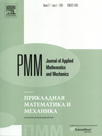 | | Journal of Applied
Mathematics and Mechanics
Russian Academy of Sciences | | Founded
in January 1936
(Translated from 1958)
Issued 6 times a year
ISSN 0021-8928
(print version) |
Archive of Issues
| Total articles in the database: | | 10610 |
| In Russian (ΟΜΜ): | | 9811
|
| In English (J. Appl. Math. Mech.): | | 799 |
|
| << Previous article | Volume 73, Issue 6 / 2009 | Next article >> |
| L.V. Kovalenko, N.N. Popov, and V.P. Radchenko, "Solution of the plane stochastic creep boundary value problem," J. Appl. Math. Mech. 73 (6), 727-733 (2009) |
| Year |
2009 |
Volume |
73 |
Issue |
6 |
Pages |
727-733 |
| Title |
Solution of the plane stochastic creep boundary value problem |
| Author(s) |
L.V. Kovalenko (Samara, Russia)
N.N. Popov (Samara, Russia)
V.P. Radchenko (Samara, Russia, radch@samtgu.ru) |
| Abstract |
The solution of the non-linear stochastic boundary-value problem of the creep of a thin plate in a plane stress state when the elastic strains are small and can be neglected is presented. The plate material is stochastically inhomogeneous so that the stress and strain tensors are random functions of the coordinates. The constitutive creep relation, taken as in non-linear viscous flow theory, is formulated in a stochastic form. Using the perturbation method, the non-linear stochastic problem is reduced to a system of three linear partial differential equations in the fluctuations of the stress tensor and, then, changing by implementing the stress function, to a differential equation, the solution of which is represented in the form of the sum of two series. The first series is the solution far from the boundary of the plate, ignoring edge effects, and the second is the solution in the boundary layer, and its terms rapidly decay as the distance from the boundary of the plate increases. The stretching of a stochastically inhomogeneous half-plane in the direction of two mutually orthogonal axes is considered as an example. The stress concentration in the boundary of the half-plane is investigated. It is shown that the spread of the stresses in the surface layer, the width of which depends on the degree of non-linearity of the material, can be much greater than in the deep layers. |
| Received |
03 December 2008 |
| Link to Fulltext |
|
| << Previous article | Volume 73, Issue 6 / 2009 | Next article >> |
|
 If you find a misprint on a webpage, please help us correct it promptly - just highlight and press Ctrl+Enter If you find a misprint on a webpage, please help us correct it promptly - just highlight and press Ctrl+Enter
|
|

 Russian
Russian  English
English